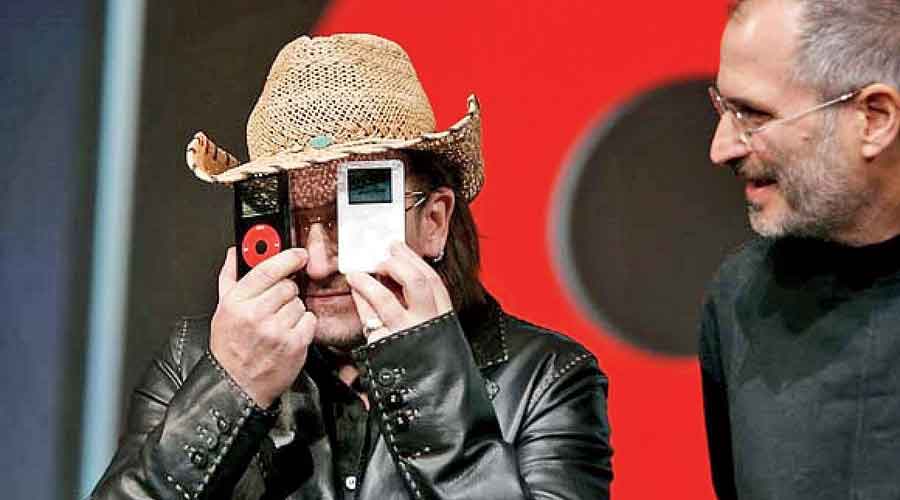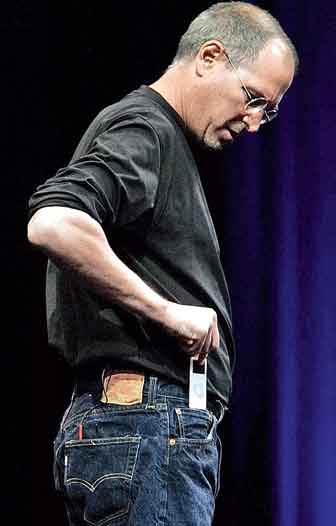Our physical connection to music was broken — beyond revival — with the arrival of the iPod in October 2001. It redefined the experience of listening to music. It changed the way music got made. It heralded the return of singles.
If you ask me my favourite singer from the 1980s that would be Bruce Springsteen; his LPs are all there, intact. From the 1990s, R.E.M. and Nirvana ruled my CD library. But when asked to name my favourite album from 2002 or 2010 or even 2020, the dial-a-friend lifeline needs to be used because music has largely whooshed past me thanks to the iPod culture. Albums? Nay, it has largely been the singles culture since that 2001 afternoon when Steve Jobs addressed a small audience: “Music’s a part of everyone’s life. Everyone. Music has been around forever and it will always be around. It’s not a speculative market. And because it’s a part of everyone’s life, it’s a very large target market all around the world. It knows no boundaries.”
And boom, he took out the iPod from his pocket and said that 1,000 songs could be stored — CD-quality — through an easy-to-use software. The focus was on 1,000 songs; not albums. Users could mix and match to make up the collection. For many, 1,000 songs were like their entire collection.
Though most of the iPod varieties have gone out of production, the iPod Touch (seventh generation) is still sold globally, though we don’t know how long it will remain that way since you can do everything on the iPhone via Apple Music. Even if it hits the dust, there’s no denying how the palm-sized gadget has brought about a change.

File picture of U2 member Bono showing off new iPods in San Jose. File picture
Lesson 1: Spoilt for choice
Unlike any device from 2001 — including any MP3 player — the iPod saved way more songs on a 5GB hard drive. Users could download an entire CD into the iPod in less than 10 seconds or 1,000 songs in less than 10 minutes, which was 30 times faster than USB-based players. But the real breakthrough revolves around democratising music. Yes, the Sony Walkman made music listening possible on the move or during your commute but you still needed cassette tapes, which took up space and carrying them in your pockets attracted lint. With the iPod, we learnt what ‘spoilt for choice’ meant — carrying an entire music collection during holidays to the mountains or anywhere in the world. Look at music streaming today, the logic remains the same.
Lesson 2: Shuffle
What makes Spotify or Apple Music playlists special is we can shuffle. So the sequence of tracks will continue to change each time we decide to play certain “stations” on, say, Apple Music. We let fate decide what comes next — Amy Grant after Amy Winehouse or The Beach Boys after The Beatles. In a way, shuffling is like a radio station — we just don’t know what the RJ is going to play.

File picture of Apple co-founder Steve Jobs. File picture
Lesson 3: Organisational skills
Like John Cusack’s Rob Gordon in the film High Fidelity, there were periods we decided to organise and reorganise records and cassettes. The arrival of the iPod also brought with it playlists. Suddenly we were making playlists for exercising, commute, relaxation, night routine, dinner and even dating. Sure, nothing can replace the magic of dropping the needle on Kind of Blue, pouring out wine and then sofa action. Suddenly it was the iPod playlist played via speakers. So a dating playlist could have had Love to Love You Baby (Donna Summer), The Sweetest Taboo (Sade), Lay It Down (Al Green), Je T’Aime… Moi Non Plus (Serge Gainsbourg) and, of course, the classic Let’s Get It On (Marvin Gaye). Even now, we make playlists on music streaming services.
Lesson 4: Singles culture
The classic album era has much to do with the music of the Beatles and albums like Rubber Soul and White Album. Then there is Bob Dylan, Pink Floyd, Beach Boys… they recorded a collection of songs that were meant to be heard in a certain order. But early rock ’n’ roll was about singles, like That’s Alright Mama by Elvis Presley or Rock Around The Clock by Bill Hailey. With iPods, we were back to listening to singles. People did download albums but since making playlists was simple and there was a shuffle feature, we wanted the ‘mix’. By 2013, Billboard had changed its chart methodology to reflect how young people were consuming music. Look at 2021, it’s all about singles.
Lesson 5: Pay for music
Before the iPod, the MP3 format bought the music industry to its knees. People were freely exchanging music without paying labels and Napster was making it possible. When iPods launched, it didn’t make an impact right away in the context of people paying for music but eventually everyone wanted an easy to way to enjoy music on the iPod. iTunes was the digital jukebox that helped us achieve it — import our favourite CDs, organise music libraries and it then became a music store of its own — an emporium where 99 cents could get you almost any song under the sun. Even though the amount was minuscule but people started paying for music.
Lesson 6: Status symbol
Much before the iPhone or the iPad, the silver finish of the iPod became symbolic of one’s lifestyle. Subway thieves and muggers were easily convinced of a person’s wealth in case the iPod was on the body, a merchandise that could be bought for hundreds of dollars was residing in the recesses of jackets. The $399 portable music player won over a generation. A survey in 2009 showed that 87 per cent youngsters in the US owned an iPod of some sort.
And you know what killed the iPod? The iPhone, which has enough space to save all your music and now you can simply stream via Apple Music. And not only did it kill the iPod, it robbed the world of an iconic accessory — the white-coloured wired earphones. iPhones now don’t even have a headphone jack. Well, the march of technology continues and the wheel of fortune — much like the wheel on the iPod — keeps rotating. But what the iPod taught Apple was that technology can be beautiful, it can take the form of a possession that fits the palm of a hand.










